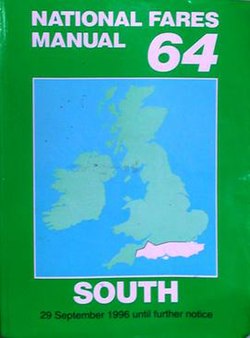National Rail (NR) is the trading name licensed for use by the Rail Delivery Group, an unincorporated association whose membership consists of the passenger train operating companies (TOCs) of England, Scotland, and Wales. The TOCs run the passenger services previously provided by the British Railways Board, from 1965 using the brand name British Rail. Northern Ireland, which is bordered by the Republic of Ireland, has a different system. National Rail services share a ticketing structure and inter-availability that generally do not extend to services which were not part of British Rail.
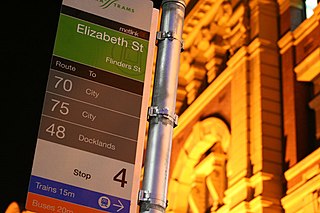
Metlink was the marketing body and umbrella brand for public train, tram and bus transport operators in Melbourne, Australia. On 2 April 2012, the operations of Metlink were transferred to the newly created public transport planning and management authority, Public Transport Victoria.

An electronic ticket is a method of ticket entry, processing, and marketing for companies in the airline, railways and other transport and entertainment industries.

Pemberton railway station serves the Pemberton area of Wigan in Greater Manchester, England. It is on the Kirkby branch line from Wigan Wallgate.

Rail Settlement Plan (RSP) is a division of the Rail Delivery Group in the United Kingdom. It provides a wide range of common services to the UK's train operating companies and third-party providers of information and retail services.

Prudhoe is a railway station on the Tyne Valley Line, which runs between Newcastle and Carlisle via Hexham. The station, situated 12 miles 1 chain west of Newcastle, serves the town of Prudhoe and villages of Mickley and Ovingham in Northumberland, England. It is owned by Network Rail and managed by Northern Trains.

Haydon Bridge is a railway station on the Tyne Valley Line, which runs between Newcastle and Carlisle via Hexham. The station, situated 29 miles 68 chains west of Newcastle, serves the village of Haydon Bridge in Northumberland, England. It is owned by Network Rail and managed by Northern Trains.
In addition to the large number and variety of short-term or localised promotional fares that have been available to passengers on the British railway network in recent decades, there are many permanent concessionary fare schemes available to passengers. Some of these take the form of Railcards, which can be purchased by people who qualify according to the conditions, and which give discounts for all journeys over a period; other concessions are available for individual journeys. In all cases, details of the type of concession will be printed on the passenger's travel ticket, to distinguish reduced-rate tickets from those sold at the standard full fare.
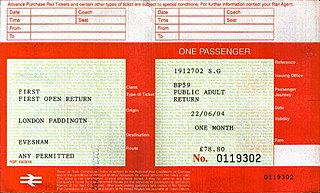
AJENTS is one of the two original computer-based railway ticket issuing systems supplied to travel agencies in Britain. It allows agencies which are not connected to one of the major GDS networks to issue and print railway tickets from a standard personal computer, and submit revenue and accounting data securely to Rail Settlement Plan Ltd for allocation to the appropriate train operating companies.

A public transport timetable is a document setting out information on public transport service times. Both public timetables to assist passengers with planning a trip and internal timetables to inform employees exist. Typically, the timetable will list the times when a service is scheduled to arrive at and depart from specified locations. It may show all movements at a particular location or all movements on a particular route or for a particular stop. Traditionally this information was provided in printed form, for example as a leaflet or poster. It is now also often available in a variety of electronic formats.

Avantix Mobile ("AVB") is a portable railway ticket issuing system used across the British railway network from 2001 to 2017.
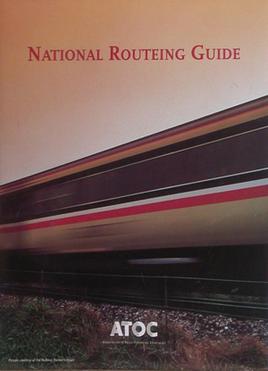
The National Routeing Guide is a document, the definitive resource on the validity of rail tickets for the purpose of rail travel in Great Britain. As stated by the Rail Regulator, "[it] sets out passengers' rights to use the network flexibly". It is a book produced by the Rail Delivery Group, which is carried by any rail ticket inspector and is also on hand for station staff.
A penalty fare, standard fare, or fixed penalty notice is a special, usually higher, fare charged because a passenger using public transport did not comply with the normal ticket purchasing rules. It should not be confused with an unpaid fares notice.
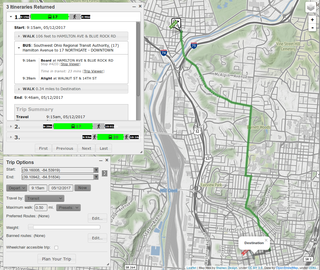
A journey planner, trip planner, or route planner is a specialized search engine used to find an optimal means of travelling between two or more given locations, sometimes using more than one transport mode. Searches may be optimized on different criteria, for example fastest, shortest, fewest changes, cheapest. They may be constrained, for example, to leave or arrive at a certain time, to avoid certain waypoints, etc. A single journey may use a sequence of several modes of transport, meaning the system may know about public transport services as well as transport networks for private transportation. Trip planning or journey planning is sometimes distinguished from route planning, which is typically thought of as using private modes of transportation such as cycling, driving, or walking, normally using a single mode at a time. Trip or journey planning, in contrast, would make use of at least one public transport mode which operates according to published schedules; given that public transport services only depart at specific times, an algorithm must therefore not only find a path to a destination, but seek to optimize it so as to minimize the waiting time incurred for each leg. In European Standards such as Transmodel, trip planning is used specifically to describe the planning of a route for a passenger, to avoid confusion with the completely separate process of planning the operational journeys to be made by public transport vehicles on which such trips are made.
qconnect was a network of integrated public passenger transport services that cover subsidised and/or regulated bus, coach and aviation networks in Regional Queensland, Australia. It was introduced by the Queensland Government in December 2007, and is an agency operated by the Department of Transport and Main Roads (TMR). qconnect provides public transport services and greater connectivity and accessibility of services throughout regional, rural and remote Queensland by working with contracted transport operators.
In Great Britain, the Sectional Appendix is a railway document compiled by Network Rail and is the official definition of railway infrastructure, giving a detailed description of all railway lines owned by Network Rail. It has traditionally been published in printed format, originally as a bound book and subsequently in loose-leaf format, for ease of updating.
A working timetable (WTT) - - The data defining all planned train and rolling-stock movements which will take place on the relevant infrastructure during the period for which it is in force; within the EU, it is established once per calendar year. The trains included may be passenger trains, freight trains, empty stock movements, or even bus and/or ship connections or replacements.
The main public transport in the Netherlands for longer distances is by train. Long-distance buses are limited to a few missing railway connections. Regional and local public transport is by bus and in some cities by metro and tram. There are also ferries.

Arriva Rail North, branded as Northern by Arriva, was a train operating company in Northern England which began operating the Northern franchise on 1 April 2016 and inherited units from the previous operator Northern Rail. A subsidiary of Arriva UK Trains, Northern was the largest train franchise in the United Kingdom in terms of the size of the network and the number of weekly services run. Its trains called at 528 stations, about a quarter of all stations in the country; of these stations 476 were operated by Northern. On 1 March 2020, Arriva Rail North Limited ceased to operate and all operations were handed to HM Government's Operator of Last Resort.

The British Rail Passenger Timetable, later the National Rail Timetable and now the Electronic National Rail Timetable (eNRT), is a document containing the times of all passenger rail services in Great Britain. It was first published by British Rail in 1974.

